|
International Harmony Based
Upon A Music Of Planetary Grid Systems
by Barbara Hero
This paper will propose a method of correlating Earth Grid systems
with specific musical notes, by a process of translating
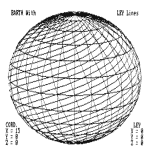 length to
frequencies which can then be translated to musical notes.
A method of octave expansion and octave reduction was used to
determine the specific frequency of a note. length to
frequencies which can then be translated to musical notes.
A method of octave expansion and octave reduction was used to
determine the specific frequency of a note.
When this theory is applied to the relationships of countries to
sounds, a way of increasing harmony between countries can be
suggested by knowing a key note of the distance between them.
A correspondence with Pythagorean Lambdoma of seven rays is
suggested.
In September of 1983 I received a letter from Governors State
University in Illinois requesting submission of information or
research on a project called THE PLANETARY GRID SYSTEM.
I wrote back
a note saying that perhaps I could help by identifying the musical
interval of the modular grid system if there is a module that has
been determined in length. Then, a year later in December, 1984,
Bethe Hagens and William Becker sent a copy of the magazine Pursuit'
which featured their research. And in this article the distances in
miles of the grid-system they devised was given, so that I could get
to work to determine certain musical relationships. I sent a letter
detailing these relationships. After receiving my letter Bethe
Hagens replied:
Thank you so much for your letter. I wanted you to know that we had
received it. I am kind of stunned by what you have found in the grid
— and your political interpretations. It's one of the most
fascinating responses we've ever received. I don't know that I told
you, but I am a professional violinist when I am not being an
anthropologist. Your work in harmonics begins to get at something I
have felt intuitively must exist but had no way to express.
... I have not had the time to sit with your letter and really
absorb it. I will write again once I have something intelligent to
say. Again, thanks so much for writing.
The Becker-Hagens report presented a theory of the growing structure
of the earth, from the tetrahedron, octahedron, cube, icosahedron,
and dodecahedron. These are the Platonic solids attributed to
Pythagoras (500 B.C.). The dodecahedron and icosahedron together,
Becker and Hagens found to be the grid system of our pre- sent age.
When the line arrays of each of these solids is overlaid on a
sphere, a grid emerges which they contend is a pattern the ancient
peoples used for becoming one with the earth.2
Briefly, factors to consider when calculating the harmonic
implications between countries, cities, or villages include the
following:
-
What is the great circle distance in miles between two points on the
grid system?
-
What are the major apex points?
-
Is the assumption that Giza is the major point valid, or has the
energy changed since the building of the Great Pyramid?
-
Are significant places in history nodes of the grid system?
-
Are fault lines energy lines?
-
Are mountain ranges energy lines?
-
What is the difference between the fault lines and the mountain
range lines in terms of energy?
-
Could certain distances portend problem areas in terms of
harmonies?
The Becker-Hagens report mentioned the Twelve Devils'
Graveyards Around the World (Saga Magazine, 1972) where magnetic and
energy aberrations were located. These are found zigzagging the
equator at 30 degrees
above
and 30 degrees below the equator.
Using an "Atlas" software computer program, Robert Foulkrod found
the distance in miles to be 4264 miles between adjacent
"Graveyards." The corresponding musical frequency based on the speed
of sound in air is 0.0000502 cps. By octave expansion to the middle
"C" octave (multiplying by 2 to the "n" number of
times), this
translates to a musical note of "A". This particular distance or
musical note might be an indication of disharmony between countries,
if, indeed, distance is a factor.
The Becker-Hagens report sets the kite shaped grid dimensions as
1400 miles (short end of the kite), 2200 miles (the outside kite
length), and 2600 miles (the brace down the middle of the kite). The
musical notes are "E flat", "A flat", and "F", respectively. The
latter note represents the distance between Gomel in the Soviet
Union and
Sebha in Libya. Therefore the musical sound of "F" at 345 cps might
be accentuated for harmony between these two countries.
The Becker-Hagens report mentioned the theory by Sinkiewitz who
claimed that the present energy grid system is out of alignment with
the ancient grid system, and that New Age Spiritual communities
around the globe are rediscovering the new grid and building sacred
sites to activate them.
The Aleutian Islands have been predicted to be the new North Pole.
See Figures 1, 2, 3, 4, & 5. What is the distance involved when a
diamond of a 70 degree apex is overlaid on the new North Pole, and
the legs of the diamond terminate at the Equator? This is the shape
which some have found intuitively very emotionally responsive as if
from a long forgotten past.
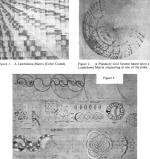 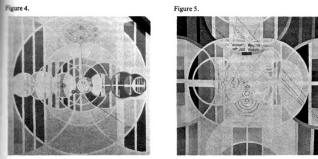
Figures 3, 4, 5
Some Visual Ways of Interpreting musical
intervals, as a prelude to applying to planetary grid system.
The method of determining the frequency of a distance is based on
formula in physics which is stated in the letter to Becker-Hagens.
v = fw
where v = (1130) the velocity of sound in air at room temperature in
ft/sec,
f = frequency in cycles/sec or Hertz
w = wavelength or distance in feet.
Because of the nature of the inverse properties of wavelength and
frequency, the frequency and wavelength canbe found if one knows the
speed of sound for the material through which the sound travels.
Through the oceans the speed of sound would be faster and hence
create a different musical note. The speed could have been taken to
be the speed of sound through granite for mountainous ridges, and a
different velocity in valleys, which would be of a less dense
material. In valleys sound would travel slower than in the
mountains, and slower still in air. One could assume that in
earthquake faults the sound would travel even faster as the density
of the entire earth would be a factor, it would seem, if in fact the
earth is denser and not hollow.
If the earth were hollow, as has been
presented by some, sound would not travel in a vacuum, and would
turn to light, since light and sound are on the same spectrum
separated only by our measuring sound in frequency and light
in wavelength. Light would travel faster in a vacuum, slower in air,
slower still in water and become sound in a dense, non-transparent
medium.
The note relating two cities or sites can readily be determined by
the formula described earlier. When a third city or site is added one
can readily determine whether the three are in harmonic accord by
using a long forgotten method of determining geometrically and
algebraically the arithmetic, geometric and harmonic means.
To illustrate, take the distance from a to b to be a given length in
miles, then take a distance from one of these sites to another. Put
the resulting lengths end to end, bisect them and draw a circle from
the halfway mark. Draw a line orthogonal to the diameter of the
circle at the point on the line of the first city or site. Where
this line meets the circle determines the geometric mean. Then draw
a line from this point on the circle to the center of the circle.
This is the arithmetic mean, and the radius of the circle. Drawing a
line orthogonal to this radius stretching to the first site defines
the harmonic mean. These distances can be translated into sounds
which would be harmonious with each one of the cities.
For example, let us take the distance between Gomel and Timbuktu of
1400 miles, and Timbuktu to Great Zimbabwe of 2200. Lets add these
in one line making a total of 3600 miles, which bisected equals 1800
miles.
The arithmetic mean would equal 1800 miles a "B" musically. The
geometric mean would equal the square root of (2200 x 1400) or 1755
miles, a "C" musically and the harmonic mean 2 x (1400 x 2200) /
(1400 2200), which equals 1711 miles, a "C#" musically. The length
between the first two cities of 1400 is an "E flat", and the length
between the second and third cities of 2200 is an "A flat". The
cities exhibit an interval of a fourth between them or "A" to "E
flat", which is a common harmonic used musically.
A "key note" of a country could be determined by means of a Lambdoma
diagram (a Pythagorean model). See Figure 6, References 3 through 8.
The apex of the Lambdoma diagram is divided equally as the diagonal
down the center of the x and y axis. The diagonal has a ratio of
1:1, so that whatever the distance is along the diagonal of the grid
would be its "key note". For example Gomel in the Becker-Hagens grid
has seven rays radiating from the apex point, and the diagonal which
represents the "key note" extends from Gomel to El Eglab, 2600 miles,
an "F" musically. From Cairo to London is 2183 miles, a "G#".
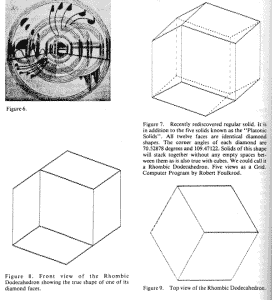
Figure 6, 7, 8, 9
Each of the rays of the grid would exhibit a unique energy, and much
work has to be done to determine the quality of these differing
energies. See Figures 7 & 8. In the case of the earth the
circumference of the earth should be taken into account as a
reference distance and frequency, the circumference is 24,860 miles.
This is equivalent to a "D" musically (in air).
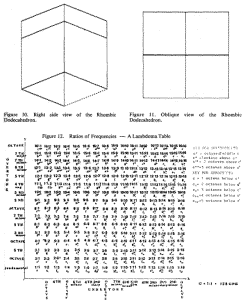
Figure 10, 11, 12
This table shows the numerical (ratio) relationships of whole
numbers to specific intervals in music. When reading across the rows
from left to right an undertone series results. When reading up the
columns beginning at the lower left an overtone series results.
Superscripts indicate the octave above middle C, and subscripts
indicate the octaves below middle C.
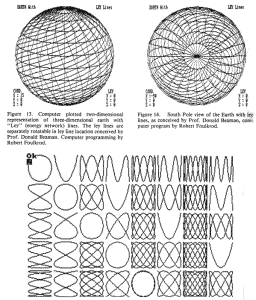
Figure 13, 14, 15
Figure 15.
Lissajous Figures. Detail of a 5x8 Lambdoma Matrix
representing an earth grid evolution as defined by Pythagorean
intervals in sounds. The individual patterns shown are "Lissajous"
patternsformed bywhole-number ratios between a fundamental tone and
its overtones and/or undertones. Computerprogram byRobert Foulkrod,
programmed in "Basic" language on an IBM PC Jr.
Envision these Lissajous Figures arrayed on the Lambdoma Diagram
matrix (Fig. 12) as a progressive series of grid lines encircling
the globe of earth, each shape sounding its specific interval.
In conclusion, if the earth is in transition in terms of developing
into a new phase of grid lines, this factor might indicate a shift of
energy or frequency at different places on the earth. See Figure 9.
The grid patterns would then take on different distances. See Figure
10. We might ask how can we as humans help the earth in this transitory phase?
First, recognizing that harmonies between cities or countries is
based upon attunement to each other's energy patterns. Most of all
let us attune ourselves to the earth's energies, recognizing the
oneness of all things in our material universe, and learning the
importance of sound as a manifestation of different realities.
Any grid system has to have distance as one of the factors, since
wavelength is inherent in all sound vibrations, as the inversion of
frequency. Even though we cannot hear the specific frequency of a
grid line, the interval quality is present though inaudible. So lets
make them audible.
REFERENCES
1) Becker-Hagens, "Pursuit Science: Pursuit of the Unexplained,"
Journal of SITU, The Society for the In-vestigation of the
Unexplained, Vol. 17, Number 2, Whole Number 66, Second Quarer,
1984.
2) Jalandris, Earthfire: Exploring the Energies of the Ancients,
Lincoln, Nebraska, 1981. 3) S. Levairie and E. Levy, Tone: A Study
in Musical Acoustics, Kent State University Press, Kent, Ohio, 1968.
4) Kayser, Hans, Akroasis: The Theory of World Harmonics, translated
by Robert Lilienfeld, Plowshare Press, Boston, 1964.
5) E. McClain,
The Pythagorean Plato: Prelude to the Song Itself,
Nicolas Hays, Ltd., New York,1978.
6) B. Hero, "Paintings Based on
Relative Pitch in Music," Leonardo, Vol. 8, pp. 13-19, Pergammon
Press,England, 1975.
7) B. Hero, "Drawings Based on Laser Lissajous Figures and the
Lambdoma Diagram," Leonardo, Vol. 11, pp. 301-303, 1978.
8) B. Hero, "The Mathematical Laws of Sound (Relationship of Sound
to Gravity)," Energy Unlimited #12, Box 288, Las Lunas, New Mexico
80731.
Figure 16
Table of Frequencies and Musical Notes Relative to Miles
in Air
This table allows one to easily find the distance correlation
in miles with musical notes and frequencies



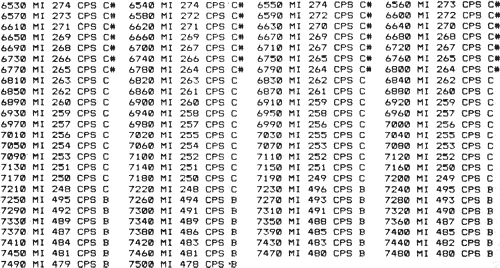
Back to Contents - Antigravity And The World Grid
|